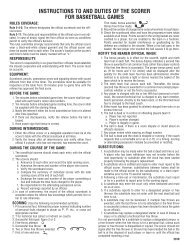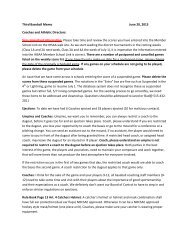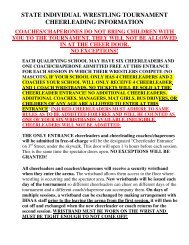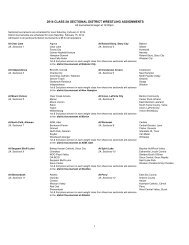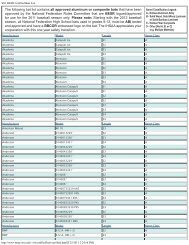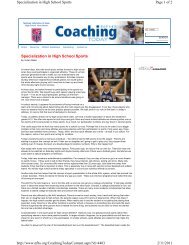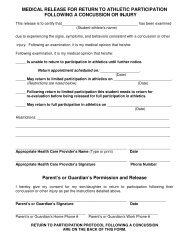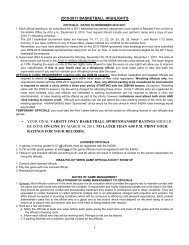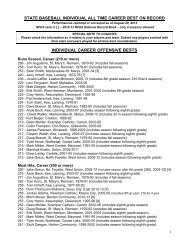Forfeit The Fat, Leave The Lean: Optimizing Weight Loss For Athletes
Forfeit The Fat, Leave The Lean: Optimizing Weight Loss For Athletes
Forfeit The Fat, Leave The Lean: Optimizing Weight Loss For Athletes
Create successful ePaper yourself
Turn your PDF publications into a flip-book with our unique Google optimized e-Paper software.
GSSI<br />
http://www.gssiweb.com/ShowArticle.aspx?articleid=48<br />
Page 1 of 9<br />
3/25/2009<br />
Print Article<br />
SSE #76: <strong><strong>For</strong>feit</strong> <strong>The</strong> <strong>Fat</strong>, <strong>Leave</strong> <strong>The</strong> <strong>Lean</strong>: <strong>Optimizing</strong><br />
<strong>Weight</strong> <strong>Loss</strong> <strong>For</strong> <strong>Athletes</strong><br />
Janet Walberg-Rankin, Ph.D., Department of Human Nutrition, Foods, and<br />
Exercise, Virginia Polytechnic Institute and State University, Blacksburg,<br />
Virginia<br />
08/04/2006<br />
FORFEIT THE FAT, LEAVE THE LEAN: OPTIMIZING WEIGHT LOSS FOR ATHLETES<br />
SSE#76 VOLUME 13 (2000) NUMBER 1<br />
Janet Walberg-Rankin, Ph.D.<br />
Department of Human Nutrition, Foods, and Exercise<br />
Virginia Polytechnic Institute and State University<br />
Blacksburg, Virginia<br />
KEY POINTS<br />
* Most active people must focus on dietary change to lose weight because they already have<br />
high rates of energy expenditure.<br />
* To reduce risk of adverse health and performance consequences, the rate of weight loss<br />
should not exceed 1-2 % of body weight per week.<br />
* Body weight goals for athletes should be based on: current body composition, time<br />
remaining until the competitive season, body weight history, and sport-specific rules.<br />
* Diet recommendations for weight loss include modest energy restriction (-500 to750<br />
kcal/d), low fat (20-25% of energy intake), moderate protein (15-25% of energy but not<br />
greater than 2 g/kg body weight per day), and high carbohydrate (60-70% of energy).<br />
* Avoid reliance on supplements and fad diets.<br />
INTRODUCTION<br />
Many athletes and others who are not necessarily overweight still would like to lose weight.<br />
<strong>The</strong>y include athletes whose performances might benefit from reductions in body weight<br />
and/or fat. As examples, a runner expends less energy if body weight is lowered, and a<br />
basketball player who reduces body weight may be able to jump higher for rebounds. In<br />
addition, wrestlers and other athletes in weight-class sports may try to move down a weight<br />
class to improve their chances of success in the sport.<br />
Dietary change can typically speed weight loss efforts relative to exercise alone. "Active"<br />
fitness club participants, for example, may feel that they are fit because they meet the<br />
Centers for Disease Control guidelines of 30 min of moderate activity on most days of the<br />
week, but this activity may require as little as 100 additional kcal/d. With no change in diet, it<br />
would take more than a month to lose 1 lb (3500 kcal) of fat as a result of this activity. To<br />
lose fat weight faster, dietary change is critical.<br />
GUIDELINES FOR DEVELOPING BODY WEIGHT GOALS<br />
Not all active people who desire weight loss should be counseled to lose weight. <strong>For</strong><br />
example, it is questionable that a lean female runner at 13% body fat could maintain good<br />
health by losing more weight. Minimum body fat guidelines for wrestlers have been<br />
suggested in a position statement from the American College of Sports Medicine (1996).<br />
This organization recommends 5% body fat as minimum for men and 12-14% for women.<br />
Recently, the National Collegiate Athletic Association (NCAA) has mandated that collegiate<br />
male wrestlers cannot be allowed to compete with a body fat equivalent to less than 5% of
GSSI<br />
http://www.gssiweb.com/ShowArticle.aspx?articleid=48<br />
Page 2 of 9<br />
3/25/2009<br />
total body weight (Natl. Coll. Atl. Assoc., 1998), and governing bodies for high-school<br />
wrestling have identified 7% body fat as the minimum (Opplinger et al., 1995). Such<br />
guidelines for minimum body fat should not be interpreted as ideal body fat for athletes. Body<br />
composition recommendations for athletes should be sufficiently flexible to allow for those<br />
who have unusual body types and weight histories. <strong>The</strong>re is no guarantee that performance<br />
in any sport will be improved as a result of weight loss. In fact, as discussed in the<br />
accompanying supplement, it could be harmful if the weight is lost inappropriately.<br />
Body fat is typically assessed with skinfold measurements, and some athletic groups,<br />
including wrestlers (Roberts, 1998) may have a sport-specific equation for estimating body<br />
fat with skinfold calipers. Once the athlete's current lean body weight has been estimated, a<br />
body weight goal can be derived using the equation in Table 1 of the supplement to this<br />
article. This equation requires the determination of a desired body fat goal, and this decision<br />
should be made after considering a variety of factors, including:<br />
* average body fat estimates for elite athletes in the particular sport or player position in the<br />
sport<br />
* amount of time available to lose weight prior to the season (according to new NCAA<br />
guidelines for wrestlers, weight loss rate should not exceed 1.5% of body weight per week or<br />
about 1 kg (2.2 lb) per week)<br />
* body weight history (e.g., athletes should rarely be expected to achieve a weight less than<br />
their lowest adult weight while eating a healthy diet)<br />
* any applicable rules of the particular sport for minimum body fat content.<br />
<strong>The</strong> athlete should get advice from a nutritionist or dietitian in making a nutrition plan for<br />
weight loss. <strong>The</strong>se professionals should exercise caution because athletes sometimes take<br />
recommendations to an extreme. <strong>For</strong> example, a belief that dietary fat reduction is the key to<br />
weight loss pushed some female bodybuilders studied in our laboratory to reduce their<br />
dietary fat to as low as 6 % of their energy intake. Such extremes can result in numerous<br />
dietary deficiencies of vitamins and minerals and are unnecessary for weight loss. Some<br />
extreme dietary behavior can be corrected once the individuals are educated about the<br />
hazards of their approaches. However, some people are unable to easily alter their dietary<br />
behaviors and obsessions. A discussion of eating disorders is beyond the scope of this<br />
paper, but those suspected of having disordered eating behaviors should be referred to<br />
appropriate professionals.<br />
RESEARCH REVIEW<br />
Successful Dietary Strategies for <strong>Weight</strong> <strong>Loss</strong><br />
It would be useful to know which strategies and/or lifestyle changes are most likely to be<br />
successful in causing long-term weight loss. Some possible strategies for achieving weight<br />
loss include counting calories consumed each day, sporadically fasting, and eliminating highcalorie<br />
or high-fat foods from the diet. Is there any evidence that one of these strategies is<br />
superior to the others? An interesting group to study with regard to this question are<br />
members of the <strong>Weight</strong> <strong>Loss</strong> Registry, people who have lost at least 30 lb and maintained<br />
that weight loss for at least 1 y (Klem et al., 1997). Almost all these people increased their<br />
physical activity to help them lose weight. <strong>The</strong> three most widely used dietary strategies in<br />
this group were limiting certain types of food (88%), limiting quantities of food (44%), and<br />
counting calories (44%). About one third of these people specifically tried to limit fat intake,<br />
and 25% counted fat grams. Estimates from food records indicated that the average fat<br />
intake of this group was 24% of daily energy intake.<br />
Data on men from the Multiple Risk Factor Intervention Trial (MRFIT) study identified<br />
changes in specific nutrients and foods that were associated with weight loss during followup<br />
(Stamler & Dolecek, 1997). <strong>Weight</strong> loss was positively associated with a) decreases in
GSSI<br />
http://www.gssiweb.com/ShowArticle.aspx?articleid=48<br />
Page 3 of 9<br />
3/25/2009<br />
consumption of refined sugar, total fat, cholesterol, and energy as the result of reducing the<br />
intake of medium-fat dairy products, eggs, visible fats, crackers, snacks, and refined sweets<br />
and b) increases in total carbohydrate and fiber caused by greater consumption of low-fat<br />
dairy foods, breads, cereals, fruits, and vegetables.<br />
Over 170 women who were at high risk of breast cancer were asked to reduce their intake of<br />
fat as part of an intervention for reducing breast cancer incidence (Sheppard et al., 1991). In<br />
spite of a lack of emphasis on weight loss, the women in the intervention group lost 3.1 kg in<br />
1 y, concurrent with a reduction in dietary fat from 39% to 22% of energy intake, compared to<br />
a loss of 0.4 kg in the control group.<br />
In summary, studies that have followed the long-term diets of both men and women find that<br />
an increase in dietary fat is associated with weight gain, and a reduction in dietary fat<br />
corresponds to weight loss. Individuals are more likely to lose weight if they reduce dietary<br />
fat to 20-25% of total calories.<br />
Dietary Guidelines for <strong>Weight</strong> <strong>Loss</strong><br />
Several professional organizations have made recommendations on dietary change for<br />
weight loss. Most include recommendations to modestly reduce total energy intake and<br />
consume a balanced, normal diet to result in a weight loss of 0.5-1 kg/wk. <strong>For</strong> example, the<br />
American Dietetic Association (1997) recommends that individuals focus on "healthy eating"<br />
rather than on dieting because except for a lower energy content, the characteristics of the<br />
diet recommended for weight loss are virtually identical to those recommended for daily living<br />
(i.e., rich in complex carbohydrates and containing fiber, fruits and vegetables, lower-fat dairy<br />
products, and lower-fat meats or meat alternatives). <strong>The</strong> American Heart Association (1994)<br />
takes a similar stand but gives specific recommendations that total energy intake not fall<br />
below 1200 kcal/d for women or 1500 kcal/d for men; they also recommend consuming 15%<br />
of energy as protein, less than 30% as fat, and at least 55% as carbohydrate, while drinking<br />
1.5-2.0 qts of fluids daily. Foods chosen should be rich in micronutrients to ensure that the<br />
diet achieves the recommended dietary allowances (RDA) for vitamins and minerals.<br />
Nutrient density (the amount of nutrients in a given number of food calories) is an important<br />
concept to emphasize when trying to discourage the person who justifies eating a low-fat<br />
cake instead of a turkey sandwich for lunch because they provide similar amounts of<br />
calories; compared to the sandwich, the cake has little nutrient value beyond its energy<br />
content.<br />
Diet and <strong>Weight</strong> Management<br />
Research is constantly being performed to try to refine the optimal dietary approach to<br />
weight loss and to determine why some people who adhere strictly to the same diet seem to<br />
be more successful than others at losing weight. Identical twins have been used to study the<br />
possibility that there is a genetic component that explains differences in ability to lose weight.<br />
Various studies have been conducted in which groups of identical twin pairs were either<br />
over- or under-fed to produce an identical change in energy balance, e.g., a negative energy<br />
balance of 1000 kcal/d. <strong>The</strong>oretically, all the individuals should lose the same amount of<br />
weight, but in fact, a wide variation among subjects has been observed. <strong>For</strong> example, in one<br />
study, among all individuals who were in negative energy balance of 1000 kcal/d for 93 d,<br />
weight loss ranged from less than 1 kg to 8 kg (Bouchard et al., 1994). However, within each<br />
twin pair, the body weight changes were very similar. This research shows that there is a<br />
genetic component to the response of body weight to negative energy balance and that one<br />
should not expect all people to lose weight at the same rate on the same recommended diet,<br />
even if they comply with the diet to the same extent.<br />
Dietary <strong>Fat</strong>. Most dietary recommendations for weight loss include a reduction in dietary fat<br />
to 30% of energy or less. <strong>The</strong> current fat intake of adults in the U.S., about 34% of energy, is<br />
lower as a percentage value than it was in the 1970s, but this is only because the total daily<br />
energy intake has risen about 200 kcal; the total amount of fat consumed by the average<br />
American each day has not changed. Only about 21% of adult males and 25% of adult<br />
females actually consume the recommended “less than 30% of calories from fat.”
GSSI<br />
http://www.gssiweb.com/ShowArticle.aspx?articleid=48<br />
Page 4 of 9<br />
3/25/2009<br />
<strong>Fat</strong> tends to increase the potential for weight gain for a variety of reasons, including the facts<br />
that:<br />
* <strong>Fat</strong> is very energy dense; it has more than twice the amount of energy found in the same<br />
weight of carbohydrate or protein.<br />
* High-fat foods tend to be palatable and desirable for many people, so they tend to eat<br />
more.<br />
* <strong>Fat</strong> is very efficiently digested and assimilated; thus, the energy required for these<br />
processes is low for dietary fat.<br />
* <strong>Fat</strong> intake does not stimulate fat oxidation, whereas carbohydrate intake does increase the<br />
body's use of carbohydrate.<br />
A series of studies completed by one laboratory shows that increasing the fat content of the<br />
diet increases the spontaneous intake of energy in normal weight individuals (Poppitt &<br />
Swan, 1998). This is likely to be largely due to the fact that the energy density of the diet is<br />
greater if more fat is included, i.e., eating the same amount of food results in greater energy<br />
intake. Evidence that this is the case comes from studies showing that as the energy content<br />
per gram (energy density) increases, the actual weight of food consumed remains constant,<br />
whereas the energy intake rises linearly.<br />
Several studies have shown that lowering dietary fat intake aids weight loss. <strong>For</strong> example,<br />
Carmichael et al. (1998) counseled overweight women to reduce their dietary fat over a 3-mo<br />
period as part of a weight loss effort. <strong>The</strong> average dietary fat intake (from diet records kept<br />
by the women) fell from 36 to 22% of calories, and the degree of success with dietary fat<br />
reduction predicted weight loss. Those women who had the most reduction in their dietary fat<br />
lost the most weight over the 3 mo. In addition, all those women who were able to reduce<br />
their dietary fat below 40 g/d lost weight.<br />
In another study of obese women afflicted with non-insulin-dependent diabetes mellitus, half<br />
the women focused only on energy restriction (1000-1500 kcal/d), whereas the other half had<br />
the same calorie reduction goal but had a fat restriction goal (
GSSI<br />
http://www.gssiweb.com/ShowArticle.aspx?articleid=48<br />
Page 5 of 9<br />
3/25/2009<br />
carefully measured the energy expenditure of female volunteers for 24 h while they<br />
consumed isocaloric diets high in either protein and carbohydrate (60% of energy as<br />
carbohydrate, 30% as protein, 10% as fat) or high in fat (60% fat, 30% carbohydrate, 10%<br />
protein). <strong>The</strong> metabolic rate following meals was about 88 kcal/d higher when the women<br />
were provided with the higher protein diet, and the total energy expenditure for the 24 h was<br />
about 80 kcal higher on that diet. Although 80 kcal/d seems small, assuming all other factors<br />
remain the same, this would theoretically result in loss of about 8 lb over a year.<br />
Crovetti et al. (1998) compared not only the energy expenditure caused by food consumption<br />
but also the effect on hunger or fullness for 7 h after consuming 557 kcal meals high in either<br />
a protein (68% of energy), carbohydrate (69%), or fat (70%). <strong>The</strong> high-protein meal caused<br />
the greatest increase in metabolic rate (about 170 kcal more expended during the 7 h after<br />
eating than the other meals) and the greatest sense of fullness. <strong>The</strong>re was no difference in<br />
fullness or post-meal energy expenditure between the meals high in fat or carbohydrate. In<br />
spite of these effects of protein consumption, the subjects ate the same number of calories at<br />
a meal fed 7 h after the test meal, regardless of the composition of the test meal. It may be<br />
that the prolonged delay (7 h) between meals reduced the chance of seeing any effect of a<br />
prior high-protein meal on subsequent food consumption.<br />
Skov et al. (1999) tested the hypothesis that a higher protein diet causes superior weight<br />
loss in obese individuals. Sixty-five obese individuals were provided with a reduced calorie<br />
diet that was either low (12% of energy) or high (25% of energy) in protein. After 6 mo, those<br />
consuming the higher protein diet lost more weight (8.9 vs 5.1 kg) and more body fat (7.6 vs<br />
4.3 kg) than did those provided the lower protein diet. Also, 35% of the subjects in the<br />
higher-protein group lost more than 10 kg, compared to only 9% of the lower-protein group.<br />
Few studies have examined the effects of diets differing in protein on weight loss in active,<br />
normal weight individuals or in athletes. However, one study from our laboratory found that<br />
male resistance trainers who for 7 d consumed a low-energy (18 kcal/kg body weight) diet<br />
containing either moderate or high amounts of protein (0.8 or 1.6 g/kg) lost similar amounts<br />
of weight (about 3.8 kg), but they lost less body protein if they consumed more protein<br />
(Walberg et al., 1988).<br />
Overall, there has been less research testing the effect of manipulation of dietary protein<br />
than dietary fat on weight loss. Thus, the following conclusions must be considered<br />
preliminary until further research confirms the current findings:<br />
* Dietary protein increases the thermic effect of a meal.<br />
* High protein meals tend to increase one’s sense of fullness.<br />
* Higher protein diets may increase total weight loss relative to average protein diets.<br />
* Higher protein diets may increase retention of body protein while dieting.<br />
<strong>The</strong>re are potential dangers of very-high protein diets, including a possible increase in<br />
dietary fat consumed as a component of some protein-rich foods, excess urinary calcium<br />
loss, elevated blood ammonia levels, and kidney dysfunction (American Dietetic Association,<br />
1993). Thus, it is recommended that individuals consume no more than 20-25% of their<br />
energy (2 g of protein per kg body weight each day) as protein.<br />
Dietary Carbohydrate. Adequate dietary carbohydrate is important during weight loss,<br />
particularly for people involved in strenuous activity. <strong>Weight</strong> loss can reduce body glycogen<br />
stores, and a weight-loss diet with little carbohydrate will exacerbate this effect.<br />
Numerous studies have found that a low-carbohydrate diet limits the performance of<br />
endurance exercise (Walberg-Rankin,1995). Even athletes participating in brief, intense
GSSI<br />
http://www.gssiweb.com/ShowArticle.aspx?articleid=48<br />
Page 6 of 9<br />
3/25/2009<br />
activities can experience a reduction in physical abilities with a low-carbohydrate, weight-loss<br />
diet. <strong>For</strong> example, wrestlers who consumed weight-loss diets containing either 41% (Horswill<br />
et al., 1990) or 55% (McMurray et al., 1991) of energy as carbohydrate experienced a<br />
decrement in their performance of high-intensity exercise, whereas those who ate 66% or<br />
70% of their energy as carbohydrate were able to maintain their pre-weight-loss<br />
performance. This suggests that many athletes who attempt to lose weight should eat at<br />
least 5 g of carbohydrate per kg body weight each day. <strong>For</strong> example, a 70 kg (154 lb)<br />
wrestler who consumes 2000 kcal/d would eat 350 g (1400 kcal) of carbohydrate each day to<br />
achieve a 70% carbohydrate diet.<br />
PRACTICAL APPLICATIONS FOR THOSE ADVISING ACTIVE INDIVIDUALS WHO WISH<br />
TO LOSE WEIGHT Recent research supports the following strategies for optimizing weight<br />
loss in active individuals.<br />
* Encourage weight loss for competitive athletes during the off-season.<br />
* Assess the individual’s initial body composition, diet, and physical activity patterns.<br />
* Determine a body weight goal based on current body composition, time prior to competitive<br />
season, body weight history, and applicable rules for the particular sport.<br />
* Discourage any rate of weight loss greater than about 1-2% of body weight per week.<br />
* Discourage weight loss for those who are already lean, and refer those whom you suspect<br />
may have disordered eating to a professional trained in this area.<br />
* Educate individuals about foods they can substitute for high-fat foods currently in their<br />
diets.<br />
* Encourage consumption of fruits and vegetables n Provide or educate about lower-fat<br />
snack choices<br />
* Encourage individuals to try reduced-fat foods<br />
* Limit fat add-ons (e.g., sour cream, high-fat salad dressings, butter, and margarine)<br />
* Emphasize the importance of reading labels to determine the nutrient contents of foods n<br />
Consider increasing the individual’s dietary protein to 2 g/kg body weight per day or up to<br />
25% of dietary energy.<br />
* Encourage individuals to consume at least 60% of their food energy as carbohydrate (at<br />
least 5 g carbohydrate per kg body weight daily).<br />
SUMMARY<br />
Active people with excess body fat should concentrate on changing their food intake to<br />
achieve negative energy balance. <strong>Weight</strong> loss can be achieved with modest dietary changes,<br />
but it should happen slowly to avoid negative effects on health and physical performance.<br />
Professionals with appropriate training in nutrition can provide education regarding<br />
appropriate food choices for safe and effective weight loss.<br />
REFERENCES<br />
American College of Sports Medicine (1996). <strong>Weight</strong> loss in wrestlers. Med. Sci. Sports<br />
Exerc. 28(2): ix-xii.<br />
American Dietetic Association (1997). Position of the American Dietetic Association: <strong>Weight</strong><br />
management. http://www.eatright.org/adaPO197.html
GSSI<br />
http://www.gssiweb.com/ShowArticle.aspx?articleid=48<br />
Page 7 of 9<br />
3/25/2009<br />
American Dietetic Association (1993). Position of the American Dietetic Association and the<br />
Canadian Dietetic Association: Nutrition for physical fitness and athletic performance for<br />
adults. http://www.eatright.org/afitperform.html<br />
American Heart Association (1994). American Heart Association guidelines for weight<br />
management programs for healthy adults.<br />
http://www.americanheart.org/scientific/statements/1994/079402.html<br />
Bouchard, A., A. Tremblay, J.P. Depres, G. <strong>The</strong>riault, A. Nadeau, P.J. Lupien, S. Moorjani,<br />
D. Prudhomme, and G. Fournier (1994). <strong>The</strong> response to exercise with constant energy<br />
intake in identical twins. Obes. Res. 2: 400-410.<br />
Carmichael, H.E., B.A. Swinburn, and M.R. Wilson (1998). Lower fat intake as a predictor of<br />
initial and sustained weight loss in obese subjects consuming an otherwise ad libitum diet. J.<br />
Amer. Diet. Assoc. 98: 35-39.<br />
Centers for Disease Control (1998). Hyperthermia and dehydration-related deaths<br />
associated with intentional rapid weight loss in three collegiate wrestlers - North Carolina,<br />
Wisconsin, Michigan, November-December 1997. Morbidity and Mortality Weekly Report. 47<br />
(6): 105-108.<br />
Crovetti, R., M. Porrine, A. Santagelo, and G. Testolin (1998). <strong>The</strong> influence of thermic effect<br />
of food on satiety. Eur. J. Clin. Nutr. 52: 482-488.<br />
Golay, A., A. Allaz, Y. Morel, N. deTonnac, S. Tankova, and G. Reaven (1996). Similar<br />
weight loss with low- or high-carbohydrate diets. Am. J. Clin. Nutr. 63: 174-178.<br />
Horswill, C.A., R.C. Hickner, J.R. Scott, D.L. Costill, and D. Gould (1990). <strong>Weight</strong> loss,<br />
dietary carbohydrate modifications, and high intensity physical performance. Med. Sci.<br />
Sports Exerc. 22: 470-477.<br />
Klem, M.L., R.R. Wing, M.T. McGuire, H.M. Seagle, and J.O. Hill (1997). A descriptive study<br />
of individuals successful at long-term maintenance of substantial weight loss. Am. J. Clin.<br />
Nutr. 66: 239-246.<br />
McMurray, R.G., C.R. Proctor, and W.L. Wilson (1991). Effect of caloric deficit and dietary<br />
manipulation on aerobic and anaerobic exercise Int. J. Sports Med. 12: 167-172.<br />
National Collegiate Athletic Association (1998). NCAA Press Release April 13, 1998.<br />
http://www.ncaa.org/news/<br />
Opplinger, R.A., R.D. Harms, D.E. Herrmann, C.M. Streich, R. Randall Clark (1995). <strong>The</strong><br />
Wisconsin wrestling minimum weight project: a model for weight control among high school<br />
wrestlers. Med. Sci. Sports Exerc. 27(8): 1220-1224.<br />
Pascale, R.W., R.R. Wing, B.A. Butler, M. Mullen, and P. Bononi (1995). Effects of a<br />
behavioral weight loss program stressing calorie restriction versus calorie plus fat restriction<br />
in obese individuals with NIDDM or a family history of diabetes. Diabetes Care 18: 1241-<br />
1248.<br />
Poppitt, S.D., and D.L. Swann (1998). Dietary manipulation and energy compensation: Does<br />
the intermittent use of low-fat items in the diet reduce total energy intake in free-feeding lean<br />
men? Int. J. Obes. 22: 1024-1031.<br />
Roberts, W.O. (1998). Certifying wrestlers' minimum weight. Phys. Sportsmed. 26: 79-81.
GSSI<br />
http://www.gssiweb.com/ShowArticle.aspx?articleid=48<br />
Page 8 of 9<br />
3/25/2009<br />
Sheppard, L, A.R. Kristal, and L. Kushi (1991). <strong>Weight</strong> loss in women participating in a<br />
randomized trial of low-fat diets. Am. J. Clin. Nutr. 54: 821-828.<br />
Skov, A.R., S. Toubro, B.Ronn, L.Holm, and A. Astrup (1999). Randomized trial on protein vs<br />
carbohydrate in ad libitum fat reduced diet for the treatment of obesity. Int. J. Obes. 23: 528-<br />
536.<br />
Stamler, J., and T.A. Dolecek (1997). Relation of food and nutrient intakes to body mass in<br />
the special intervention and usual care groups in the Multiple Risk Factor Intervention Trial.<br />
Am. J. Clin. Nutr. 65: 366S-373S.<br />
Walberg J.L., M.K. Leidy, D.J. Sturgill, D.E. Hinkle, S.J. Ritchey, and D. R. Sebolt. (1988).<br />
Macronutrient content of a hypoenergy diet affects nitrogen retention and muscle function in<br />
weight lifters. Int. J. Sports Med. 9: 261-266.<br />
Walberg, J., C.E. Edmonds, and F.C. Gwazdauskas (1993). Detailed analysis of the diets<br />
and bodyweights of six female bodybuilders before and after competition. Int. J. Sport Nutr.<br />
3: 87-102.<br />
Walberg-Rankin, J. (1995). Dietary carbohydrate as an ergogenic aid for prolonged and brief<br />
competition in sport. Int. J. Sport Nutr. 5: S13-S28.<br />
Walberg-Rankin, J. (1998). Changing Body <strong>Weight</strong> and Composition in <strong>Athletes</strong>. In: D. R.<br />
Lamb and R. Murray (eds) Perspectives in Exercise Science and Sports Medicine, Vol 11:<br />
Exercise, Nutrition, and <strong>Weight</strong> Control. Carmel, IN: Cooper Publishing Group, pp 199-242.<br />
Westerterp, K.R., S.A.J. Wilson, and V. Rolland (1999). Diet induced thermogenesis<br />
measured over 24 h in a respiration chamber: effect of diet composition. Int. J. Obes. 23:<br />
287-292.<br />
Centers for Disease Control (1998). Hyperthermia and dehydration-related deaths<br />
associated with intentional rapid weight loss in three collegiate wrestlers - North Carolina,<br />
Wisconsin, Michigan, November-December 1997. Morbidity and Mortality Weekly Report. 47<br />
(6): 105-108.<br />
<strong>The</strong> Gatorade Sports Science Institute® was created to provide current information on<br />
developments in exercise science, sports nutrition, and sports medicine and to support the<br />
advancement of sports science research.<br />
<strong>For</strong> additional information:<br />
In the U.S.A. and Canada: 1-800-616-GSSI<br />
(4774)<br />
Outside the U.S.A.: 847-967-6092<br />
International Online:<br />
http://www.gssiweb.com/<br />
Gatorade Sports Science Institute®<br />
Fulfillment Agency<br />
P.O. Box 75886,<br />
Chicago, IL 60675-5886<br />
U.S.A.<br />
© 2000 Gatorade Sports Science Institute PRINTED ON RECYCLED PAPER<br />
This article may be reproduced for non-profit, educational purposes only.
GSSI<br />
http://www.gssiweb.com/ShowArticle.aspx?articleid=48<br />
Page 9 of 9<br />
3/25/2009



